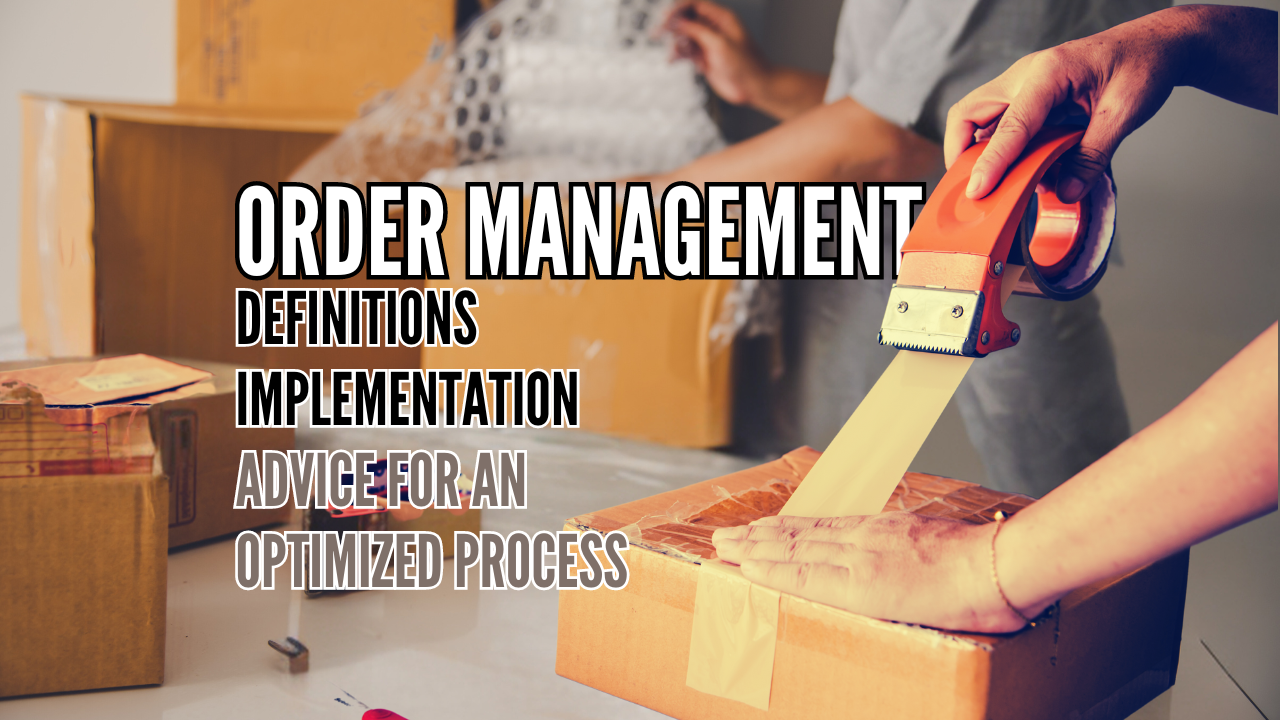
Good order management is an essential element for the success of your e-commerce. Customer satisfaction, logistics optimization, reduction of costs and losses… Adopting an effective order management method will not only allow you to keep your business in good health, but also to keep satisfied customers. Find out here how to implement an order management strategy adapted to your e-commerce and your ambitions.
Order Management: Definition
Order management refers to the complete process from receiving an order to delivering it to the final customer. It involves order placement, processing, packaging, shipping, and handling potential returns. Thus, order management encompasses all operational aspects of e-commerce transactions. Its effectiveness is measured by swift and impeccable product delivery to customers. The primary goal is to provide a positive customer experience by optimizing internal processes.
What are the stages of the order management process?
- Placing an order
- Order processing
- Payment and billing
- Order preparation
- Shipping & Delivery
- Returns management
- Customer service
Order Placement
Order placement signifies a customer expressing the intention to purchase a product offered online by adding items to the virtual cart. The actual order placement occurs during the payment stage, where the customer selects their preferred online payment method (credit card, e-wallet, sometimes bank transfer). Once payment is confirmed, the order is placed, and the seller receives a notification.
Order Processing
For the receiving company, order processing involves steps to ensure the product can be shipped. This requires a robust notification system for order reception, enabling swift stock checks. Order processing also involves verifying the shipping address and payment information.
Payment and Invoicing
Payment and invoicing involve collecting funds for the customer’s purchase and generating an invoice detailing the transaction. This step is crucial for accurate and transparent accounting, emphasizing the use of secure payment methods.
Order Preparation
Order preparation entails locating, gathering, and packaging the specified items in the customer’s order. It involves precise assembly, ensuring the product referenced in the order matches the one prepared for shipping, facilitating the subsequent shipping stage.
Shipping and Delivery
Shipping and delivery refer to physically transporting products from the company’s warehouse to the customer’s delivery address. Choosing carriers, tracking packages, and logistical coordination are essential components for successful timely deliveries. Clear and defined shipping policies are crucial.
Returns Management
Managing returns involves a well-defined process to handle products returned by customers due to defects, order-related issues, or personal preferences (e.g., wrong size or color). It includes offering customers an easy return method and establishing a precise refund policy.
Customer Service
Customer service is involved throughout the order management process, serving as a primary point of contact between customers and suppliers. Effective customer service assists customers with inquiries about company operations or products, accompanying them during crucial order stages, and reassuring them in situations like delayed deliveries or product returns. It’s a pivotal step for fostering loyalty and ensuring high customer satisfaction.
Order Management: How to Efficiently Manage Stocks?
Stock Management: Definition
Stock management involves monitoring and controlling the quantity of goods stored by a company, considering factors like weight, dimensions, quantities, and location. Effective stock management aims to reduce costs associated with stock maintenance by determining the ideal time for replenishing products or raw materials. It’s an integral part of efficient order management and can be optimized in various ways, listed below.
1. Implement Real-Time Stock Tracking
Companies can opt for different methods to manage their stock and keep track of available items. Whether maintaining a manual tracking file or utilizing real-time stock management software like Odoo, an updated real-time stock file is crucial. Accurate and regularly updated data is vital for effective product management, enabling safe and swift goods dispatch.
2. Anticipate Demand (Just-in-Time)
Not all items for sale experience the same demand throughout the year. When stocking up, consider periodicity. Peak periods like Christmas, sales, or Valentine’s Day may affect your products; adjust your orders from suppliers accordingly to avoid stockouts.
3. Prioritize Products Based on Demand
Over time, disparities in demand for different products become apparent. Analyzing the nature of orders from customers helps identify your inventory’s top-selling products. Consider different distribution channels to see if certain products sell better online or in physical stores, for instance. Adjusting stocks based on demand and different purchasing channels aims to avoid stockouts and misallocated storage costs.
4. Manage Orders with Suppliers
Once identifying high-demand products and those not requiring constant restocking, place orders with suppliers. This ordering stage can be automated using certain management software. Set a restock point (e.g., when only 5 items remain in stock or 200 units of a product). The restock point should align with your company’s size, demand volume for different products, and stock size.
5. Aim for Reduced Storage Costs
Efficient stock management should optimize costs related to storing goods. Renting a warehouse incurs expenses, and even for a small business, poorly managed stock storage, either underutilized or overused, involves hidden costs. Mismanaged stock results in fewer opportunities to supply desired items to customers and less flexibility in your offerings.
How to Establish an Effective After-Sales Service?
- Define a Clear Return Policy
- Choose a Simple Return Process
- Set up a Dedicated Customer Service Platform
- Process Returns and Refunds
- Promptly Take Time to Analyze Return Reasons
Define a Clear Return Policy
Develop a clear, easy-to-understand return policy accessible to all customers. Specify return conditions, deadlines, return procedures, and ensure this policy is visible on your website or accompanies your shipments.
Choose a Simple Return Process
Make the return process as simple as possible for your customers. Provide, for example, pre-paid return labels inside your packages or make label printing easily accessible online. The return drop-off point should also be easily reachable (Post Office or pickup points): facilitate returning packages for your customers.
Set up a Dedicated Customer Service Platform
Establish a customer service platform accessible to all. It could be a call center or a live chat service on your e-commerce site. The platform should offer a space for customers to ask about returning items, inquire about pending orders, and seek assistance.
Process Returns and Refunds Promptly
Nobody appreciates waiting six months for a refund after returning an unsuitable item. Similar to order processing, implement an efficient return management process that keeps your customers informed. Clearly communicate with customers throughout the process: send them an email or notification upon receiving their return package or when the refund has been transferred to their account. Here again, order and return management software can automate your company’s return management process.
Take Time to Analyze Return Reasons
As a company, utilize returned products as an opportunity to enhance your offerings. Offer customers a means to provide reasons for returning a purchased product. By analyzing the various reasons for customer returns, you can improve your product nature or process.
What are the Advantages of Adopting an OMS?
An Order Management System (OMS) refers to software used to handle the entire order management process in a commercial environment. It proves highly beneficial for centralizing and automating various stages of the order lifecycle, from customer order placement to product delivery. Adopting an OMS offers multiple advantages, detailed below.
Centralized Orders
An OMS consolidates orders from various sales channels (online store, physical shop, marketplace) into one system. This simplifies order management, minimizes errors from combining orders across different channels, and provides a better overview of stocks and sales.
Improved Inventory Management and Visibility
With an OMS, stocks are monitored in real-time, offering better inventory visibility. This helps avoid stockouts and overstock situations and enables easier supplier replenishments. Better-managed inventory leads to reduced storage costs and increased customer satisfaction (fewer stockouts mean fewer disappointed customers and more sales!).
Optimized Shipping
Beyond stock tracking, an OMS can optimize the entire order shipment process, including labeling and carrier selection. This reduces shipping time, errors, and delays, ultimately enhancing customer satisfaction.
Moreover, you can offer customers various delivery options (home delivery, pickup points, Click and Collect) effortlessly. The delivery address is collected by the OMS and forwarded to the carrier at the right time.
Enhanced Order Tracking
An OMS allows tracking orders at every stage, from order placement to final delivery. This provides real-time information to customer service teams and customers themselves about their order status, reinforcing their confidence in the company and the transparency of the entire ordering process.
Simplified Returns Management
The OMS simplifies returns management by automating processes for handling returned items. Centralizing information allows you to provide return labels for customers to easily return products ordered online. Once returned to the warehouse or your company’s premises, scanning the code on the label provides essential information about the returned product, order and delivery date, customer, and refund amount.
Transparent Processes
By centralizing essential information for order management, an OMS offers complete traceability of your products. Besides significantly streamlining online order logistics, an OMS can provide valuable data on sales and performance. Analyzing sales from different sales channels, primary reasons for returned goods, and implementing a customer service that gathers client grievances helps you improve processes. An OMS offers greater transparency in all your processes, allowing your teams to identify areas for improvement and work on them effectively.





